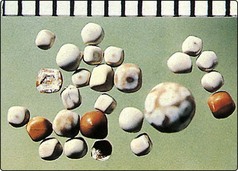72 Nucleic acids contain bases of two different types, pyrimidines and purines. The catabolism of the purines, adenine and guanine, produces uric acid. At physiological hydrogen ion concentration, uric acid is mostly ionized and present in plasma as sodium urate (Fig 72.1). An elevated serum urate concentration is known as hyperuricaemia. Uric acid and sodium urate are relatively insoluble molecules that readily precipitate out of aqueous solutions such as urine or synovial fluid (Fig 72.2). The consequence of this is the medical condition gout. Urate is formed in three ways. These are: Urate is excreted in two ways: Urate concentrations in serum are higher in men than women. Even within the reference interval, serum urate is near its aqueous solubility limit. The presence of protein helps to keep the molecule in solution. A high serum urate may arise from increased urate formation, or from decreased excretion. The common causes of hyperuricaemia are summarized in Figure 72.3. Genetic causes of hyperuricaemia are known as primary disorders, and there are also secondary causes. Most primary causes are due to decreased excretion of urate (90% of cases) rather than increased production (10%).
Hyperuricaemia
Urate formation and excretion
 Via the kidney. The majority of urate is excreted via the kidney. Renal handling of urate is complex. It is freely filtered at the glomerulus, but 99% is reabsorbed in the proximal tubule. The distal tubules also secrete urate, but again much is reabsorbed. The amount of urate excreted in the urine is around 10% of that filtered at the glomerulus.
Via the kidney. The majority of urate is excreted via the kidney. Renal handling of urate is complex. It is freely filtered at the glomerulus, but 99% is reabsorbed in the proximal tubule. The distal tubules also secrete urate, but again much is reabsorbed. The amount of urate excreted in the urine is around 10% of that filtered at the glomerulus.
 Via the gut. Smaller amounts of urate are excreted into the gut where it is broken down by bacteria. This process is called uricolysis.
Via the gut. Smaller amounts of urate are excreted into the gut where it is broken down by bacteria. This process is called uricolysis.
![]()
Stay updated, free articles. Join our Telegram channel

Full access? Get Clinical Tree


Basicmedical Key
Fastest Basicmedical Insight Engine





